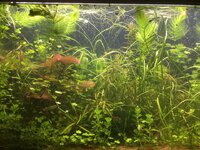Soilwork
Member
- Joined
- 22 Nov 2015
- Messages
- 559
A question for those that don’t want to fertilise their plants. Why use a filter?
I can understand the reason behind encouraging massive microbial nitrification in a water treatment facility but in a planted tank that doesn’t use fertiliser you filter is removing ammonia and microscopic particulate food for your critters. Let the plants do the work and feed heavily. I don’t agree with all of Diana Walstads principals but she was right when she said ‘you’re not feeding the fish, you’re feeding the plants’
If you allow the mulm to build up in the substrate gives a better medium for your plants to grow in over time and doesn’t encouraging high turnover increase oxygen demand? I know this can easily be overcome but I prefer slower flow, no mechanical filtration and overfeeding. There is definitely a better response in these kind of natural aquariums in my experience.
Cheers CJ
I can understand the reason behind encouraging massive microbial nitrification in a water treatment facility but in a planted tank that doesn’t use fertiliser you filter is removing ammonia and microscopic particulate food for your critters. Let the plants do the work and feed heavily. I don’t agree with all of Diana Walstads principals but she was right when she said ‘you’re not feeding the fish, you’re feeding the plants’
If you allow the mulm to build up in the substrate gives a better medium for your plants to grow in over time and doesn’t encouraging high turnover increase oxygen demand? I know this can easily be overcome but I prefer slower flow, no mechanical filtration and overfeeding. There is definitely a better response in these kind of natural aquariums in my experience.
Cheers CJ



